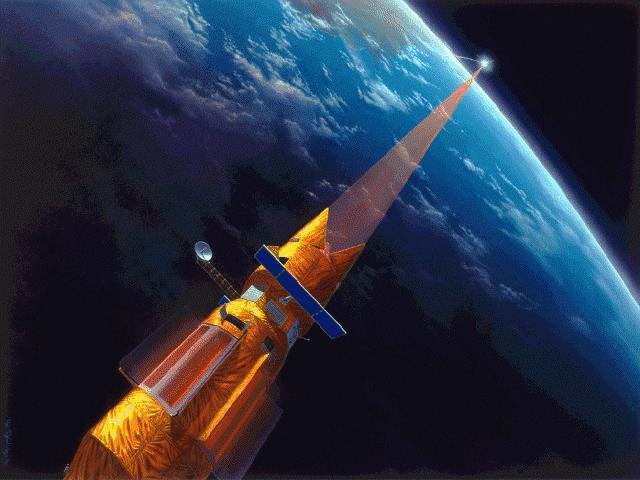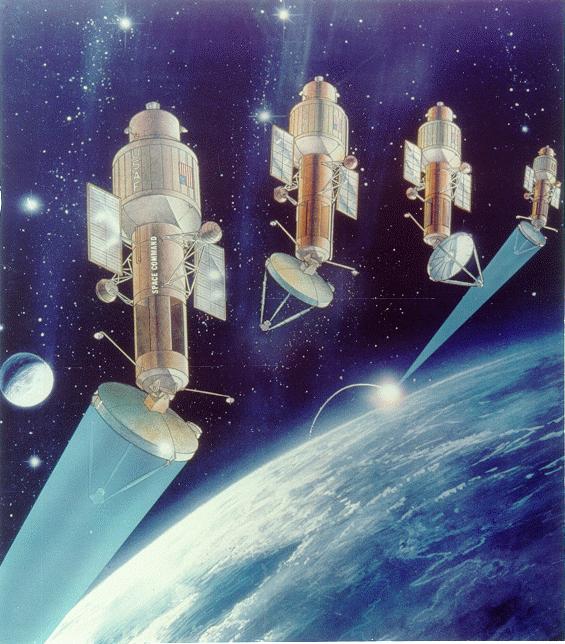| Space Based Laser [SBL]
美国天基激光系统(SBL) Date:2016-04-11 Source:fas By:Globalmil Viewed: |

The potential to intercept and destroy a missile over enemy territory soon after launch, rather than over friendly territory, makes the development of a boost phase intercept (BPI) capability very desirable. In concert with ground based theater missile defense (TMD) systems already under development, the U.S. continues to investigate BPI concepts for BMD systems.
潜在能力拦截并且摧毁在敌人的领土上发射不久的一枚导弹,而不是在友好的领土,使得发展一个助推段拦截(BPI)能力是非常可取。和已经在开发中的地面战区导弹防御(TMD)系统相呼应,美国继续研究助推段拦截(BPI)概念。
The SBL program could develop the technology to provide the U.S. with an advanced BMD system for both theater and national missile defense. BMDO believes that an SBL system has the potential to make other contributions to U.S. security and world security as a whole, such as inducing potential aggressors to abandon ballistic missile programs by rendering them useless. Failing that, BMDO believes that the creation of such a universal defense system would provide the impetus for other nations to expand their security agreements with the United States, bringing them under a U. S. sponsored missile defense umbrella.
SBL计划可以发展技术为战区和全国导弹防御提供一个先进的弹道导弹防御(BMD)系统给美国。BMDO相信一个SBL系统潜在的去获得另外的贡献总体上对美国安全性和世界安全性,例如产生诱导作用,潜在攻击者去放弃弹道导弹计划依据它们表现是无效的。否则,BMDO 相信一个如此万用的防卫系统的产生会提供动力给其他的国家扩张他们的安全性同意和美国一致,产生他们在一个美国发起的导弹防御伞下面的结果。
An SBL platform would achieve missile interception by focusing and maintaining a high powered laser on a target until it achieves catastrophic destruction. Energy for the sustained laser burst is generated by the chemical reaction of the hydrogen fluoride (HF) molecule. The HF molecules are created in an excited state from which the subsequent optical energy is drawn by an optical resonator surrounding the gain generator.
一个SBL平台会完成导弹拦截被一个聚集并且维持一束高能激光在一个目标上直到达到灾难的破坏。能量因为持续不变的激光脉冲氢氟化物 (HF) 分子的化学反应产生。HF分子在一个激发态中被创造从并发的光学能量是被一个光学共振器围绕物增益发生器引起。
Lasers have been studied for their usefulness in air defense since 1973, when the Mid Infrared Advanced Chemical Laser (MIRACL) was first tested against tactical missiles and drone aircraft. Work on such systems continued through the 1980s, with the Airborne Laser Laboratory, which completed the first test laser intercepts above the earth. Initial work on laser based defense systems was overseen by the Defense Advanced Research Projects Agency (DARPA), but transferred to the newly created Strategic Defense Initiative Organization (SDIO) in 1984. Work continues today under the auspices of the BMDO, the successor to the SDIO.
自从1973年以后激光已经被研究因为它们有效性从事于防空,当中间红外光先进的化学激光器 (MIRACL) 在那时候被首先测试对抗战术导弹和无人驾驶(遥控)飞机的时候。1980年在如此的系统上的工作自始至终延续,关于空运的激光实验室, 完成了在地面上的第一次激光拦截测试。建立在激光上的防卫系统初次工作被先进的远景研究计划代理处(DARPA)管理, 但是在1984年对新建立的战略防御主动机构(SDIO) 转交防卫监督了。工作到今天由BMDO 主办赞助之下延续,由SDIO后继。
The SBL program builds on a broad variety of technologies developed by the SDIO in the 1980s. The work on the Large Optics Demonstration Experiment (LODE), completed in 1987, provided the means to control the beams of large, high powered lasers. The Large Advanced Mirror Program (LAMP) designed and built a 4 meter diameter space designed mirror with the required optical figure and surface quality. In 1991, the Alpha laser (2.8 mm) developed by the SDIO achieved megawatt power at the requisite operating level in a low pressure environment similar to space. Numerous Acquisition, Tracking, and Pointing/ Fire Control (ATP/ FC) experiments both completed and currently underway will provide the SBL platform with stable aimpoints. Successes in the field of ATP include advances in inertial reference, vibration isolation, and rapid retargeting/ precision pointing (R2P2). In 1995 the Space Pointing Integrated Controls Experiment offered near weapons level results during testing.
SBL计划技术建立在一个广泛多样性上被SDIO在1980年发展。工作在大规模光学实证实验(LODE)上,1987年全部完成,倘若这方法去控制大量的光束,高度使激光具有力量。大规模光学实证实验(LODE)有计划并且建造一个4m直径空间计划镜子使用必需的光学形体和表面质量。在1991年,被SDIO发展的Alpha激光(2.8mm)在必不可少的运行标准方面达到兆瓦特功率,在一个和空间相似的低(大气)压环境中。多数的捕获、跟踪,和指示/射击控制 (ATP/FC) 实验两者全部的并且当前航行中,将会提供稳定的瞄准点(aimpoints)给SBL平台。ATP领域的成功包括在惯性基准内接近,隔离振动和迅速的再对准/ 精确瞄准点(R2P2)。在1995年空间点综合控制器在测试期间提供接近武器水平结果。
Most recently, the Alpha LAMP Integration (ALI) program has performed integrated high energy ground testing of the laser and beam expander to demonstrate the critical system elements. The next step is an integrated space vehicle ground test with a space demonstration to conclusively prove the feasibility of deploying an operational SBL system.
最近,Alpha LAMP 整合(ALI) 计划已经执行综合高能地面测试对于激光和光束扩展器去论证临界系统原理。运行激光和光束整合高能测试扩展器示范具决定性的系统机械要素。下一个阶段是综合空间运载体地面测试,用一个空间实证去最后地证明展开一个运作的SBL系统的可行性。
Future plans include orbiting the SBL Readiness Demonstrator (SBLRD) in order to test all of the systems together in their intended working environment. Designs for the SBLRD satellite call for four major subsystems: the ATP system; providing acquisition, tracking, targeting, stabilization, and assessment capabilities; the laser device, providing the optical power, and beam quality, as well as maintains nozzle efficiency; the optics and beam control systems, enhancing and focus the beam, augmenting the capabilities of the laser device; and the space systems, providing a stable platform, storage of the reactants, and furnish electrical power (but do not power the laser).
未来计划包括轨道运行SBL准备就绪论证系统(SBLRD),为了测试全部系统共同在他们的有意工作的环境中。设计用于SBLRD卫星要求四个主要的子系统:ATP 系统;提供捕获、跟踪、瞄准、稳定、和评估能力;激光装置,提供光学能量和光束质量,也维持喷嘴效率;光和光束控制系统,增强和聚焦光束,增加激光装置的性能;空间系统,提供一个稳定平台,反应物储存,而且供给电力( 但是不使激光有能量)。
The SBLRD is intended to demonstrate the capability to perform boost phase Theater Missile Defense from space. The objectives of the space demonstration include gaining performance information critical to the development of an operational SBL system, as well as gain a general understanding of operating such a system.
SBLRD 预计示范能力从空间去执行助推段战区导弹防御。空间示范目标包括增进性能信息鉴定去发展一个运作的SBL系统,也增加一个概要理解运行的这样一个系统。
BMDO and the Air Force agreed to transfer the execution of the SBLRD project and the related SBL technology developments to the Air Force. BMDO retained overarching SBL architecture responsibilities.
BMDO 和美国空军已经过协议去移交SBLRD 计划的运行和相关的SBL技术发展给美国空军。BMDO 保留在 SBL 体系结构职责上全部延及。
Alpha High Energy Laser (HEL)
Alpha 高能激光
Megawatt class power levels were first achieved by the Mid-Infrared Advanced Chemical Laser (MIRACL) originally sponsored by the Navy, later by DARPA, and then by BMDO. Because the design was intended for sea level operation, the MIRACL laser does not achieve the optimum efficiency necessary for space-based operation. DARPA launched the Alpha laser program, with the goal of developing a megawatt level SBL that was scaleable to more powerful weapon levels and optimized for space operation. In this design, stacked cylindrical rings of nozzles are used for reactant mixing. The gain generation assembly achieves higher power by simply stacking more rings. In 1991, the Alpha laser demonstrated megawatt class power levels similar to MIRACL, but in a low pressure, space operation environment. Alpha demonstrates that multi-megawatt, space-compatible lasers can be built and operated.
最初被美国海军主办兆瓦级功率水平被中间-红外线(Mid-Infrared)先进化学激光器(MIRACL)首先达到,然后被BMDO。因为设计有意为海平面操作,MIRACL激光工作没有达到最佳效率,必需用于天基(space-based)运转。DARPA开始了Alpha激光计划,用于目的对于发展中的一个兆瓦特水平SBL是可依比例达到更强大武器水平并且使最优化用于空间运转。在这一个设计中,堆积喷嘴的圆筒形的环作为反应物混频。增益发生组合装置达到更高的功率通过只是叠加更多的环。在1991年,Alpha激光示范了兆瓦特级功率水平类似对MIRACL,但是在一个低压中,空间操作环境。Alpha示范那一个多种-兆瓦特(multi-megawatt),空间-相容(space-compatible)的激光能被建造而且操作。
Large Advanced Mirror Program (LAMP)
巨大先进反射镜计划
To demonstrate the ability to fabricate the large mirror required by an SBL, the Large Advanced Mirror Program (LAMP) built a lightweight, segmented 4 m diameter mirror on which testing was completed in 1989. Tests verified that the surface optical figure and quality desired were achieved, and that the mirror was controlled to the required tolerances by adaptive optics adjustments. This mirror consists of a 17 mm thick facesheet bonded to fine figure actuators that are mounted on a graphite epoxy supported reaction structure. To this day, this is the largest mirror completed for use in space. This LAMP segmented design is applicable to 10 m class mirrors, and the Large Optical Segment (LOS) program has since produced a mirror segment sized for an 11 m mirror. The large dimension of this LOS mirror segment approximates the diameter of the LAMP mirror
为了要示范能力制造一个SBL必需的巨大反射镜,巨大先进反射镜计划 (LAMP) 建造一个轻量级,分割4 m直径反射镜在上面测试1989 年完成。测试核实那表面的光学形体和想得到的质量被达到,而且反射镜是受约束对必需的容许度被自适应光学调节器。这一个反射镜由一个17mm厚的薄片面有保证的精细外形操动件那是安装在一个石墨环氧支承反力(supported reaction )结构。至今,这是最大的反射镜为空间的使用完成。这一个被分割设计的LAMP可以应用在10 m等级反射镜,而且巨大光学片段 (LOS) 计划以后引长一个反射镜,有对于一个11m 反射镜大小片段。巨大尺寸对于这个反射镜片断近似的直径由LAMP制成的。
Beam Control- Large Optics Demonstration Experiment (LODE) and ALI
光束控制-巨大光学实证实验 (LODE)和ALI
The ability to control a beam was demonstrated at low power under the Large Optics Demonstration Experiment (LODE) in 1987. The current high power beam control technology is now being integrated with the Alpha laser and the LAMP mirror in a high power ground demonstration of the entire high energy laser weapon element. This is known as the Alpha-LAMP Integration (ALI) program.
要控制一个光束的能力在 1987 年被低功率在巨大光学实证实验(LODE)之内示范。目前的高功率光束控制技术是现在存在完整的,用Alpha激光和LAMP反射镜在一个高能地面示范对于全部高能激光武器元件。这是大家知道的被看作Alpha-LAMP整合(ALI) 计划。
Acquisition, Tracking, Pointing (ATP)
捕获,跟踪,指示(APT)
The ATP technologies required (sensors, optics, processors, etc.) have been validated through a series of component and integrated testing programs over the last decade. In 1985, the Talon Gold brassboard operated sub-scale versions of all the elements needed in the operational ATP system including separate pointing and tracking apertures, an illuminator, an inertial reference gyro system, fire control mode logic, sensors and trackers. Talon Gold achieved performance levels equivalent to that needed for the SBL. In 1991, the space-borne Relay Mirror Experiment (RME), relayed a low-power laser beam from a ground site to low-earth orbit and back down to a scoring target board at another location with greater pointing accuracy and beam stability than needed by SBL. The technology to point and control the large space structures of the SBL was validated in 1993 by the Rapid Retargeting and Precision Pointing (R2P2) program that used a hardware test bed to develop and test the large and small angle spacecraft slewing control laws and algorithms. The Space Pointing Integrated Controls Experiment (SPICE) demonstrated in 1995 near weapon scale disturbance isolation of 60-80 db and a pointing jitter reduction of 75:1. In 1998, the Phillips-Laboratory-executed High Altitude Balloon Experiment, (HABE) will demonstrate autonomous end-to-end operation of the key ATP-Fire Control (FC) functions in a realistic timeline against actual thrusting ballistic missiles. HABE will use a visible low-power marker beam as a surrogate to the megawatt HF beam and measure beam pointing accuracy, jitter and drift against a fixed aimpoint on the target.
必需的ATP技术(传感器,光,处理器等)在最后十年以来经过一系列的构件并且整合的测试计划已经使有效。在1985年,金爪(Talon Gold)实验性的次-等级版本关于所有的基础需要在运作ATP系统包括,分开的点和跟踪孔径所有操作在包括分开的操作ATP系统中被需要的,一个照明系统,惯性基准陀螺系统,射击控制模态逻辑,传感器和追踪系统。金爪(Talon Gold)达到性能水平对SBL的需要等效。在1991年,空间-转向(space-borne)转播(激光束在空间被转换方向)反射镜实验(RME),转播一个低-功率激光束从一个地面站点到低-环地轨道并且返回下至在另外的位置一个记分靶板,用于区域点精确性和束稳定性与被SBL需要比较。点并且控制SBL的巨大空间结构的技术要在1993年确认被迅速再对准和精确点(R2P2)计划 那使用一个硬件试验台去发展和测试巨大并且小角度太空船快速瞄准控制规律和算法。空间指示综合控制实验(SPICE)在近1995年武器测量扰动隔离度对于60-80db和一个75:1指示抖动还原。在1998年,飞利浦-实验室-完成高空气球实验(HABE),将会示范自主的端-到-端(end-to-end)操作对于关键ATP-射击控制(FC)功能,在一个现实时间期限真正的反制有强大推进力的弹道导弹。HABE 将使用一个显著的低-功率(low-power)作记号光束被看做一个来代替对兆瓦特HF光束和测量光束指向精度,抖动和漂移反击一个确定好的在目标上的瞄准点。
Current SBL planning is based on a 20 satellite constellation, operating at a 40� inclination, intended to provide the optimum TMD threat negation capability. At this degree of deployment, kill times per missile will range from 1 to 10 seconds, depending on the range from the missile. Retargeting times are calculated at as low as 0.5 seconds for new targets requiring small angle changes. It is estimated that a constellation consisting of only 12 satellites can negate 94% of all missile threats in most theater threat scenarios. Thus a system consisting of 20 satellites is expected by BMDO to provide nearly full threat negation.
目前的SBL计划以一个20颗卫星星座为基础,操作在一40度磁倾角(40? Inclination),想要提供最适宜TMD威胁反击能力。在配置的这一个程度,杀伤次数每导弹从1到10秒起将会排列,依赖来自导弹的范围。再对准次是在像0.5秒一样的少为新的目标需要小的角变化被计算出来的。一般估计由仅仅12个宇宙站所组成的一个星座能打消(negate)最大多数的战区所有导弹威胁情况的94%。如此由20个宇宙站所组成的一个系统被BMDO期望几乎完全地提供威胁打消。

SBLRD Characteristics
Weight: 17,500 kg
Length: 20.12 m
Diameter: 4.57 m
Mirror Diameter: 4.0 m
- Hydrogen fluoride chemical energy powered laser.
- On board surveillance capabilities.
- Super reflective mirror coatings allowing for uncooled optics.
- Concurrent NMD / TMD capability.
重量:17,500 kg
长度:20.12 m
直径:4.57 m
反射镜直径:4.0 m
·氢氟化物化学能激励激光。
·在操纵台上(On board)监视能力。
·极好的反射镜涂敷允许用于未冷却的光。
·NMD/TMD 协作能力。
上一篇:没有了 下一篇:没有了
| Space Based Laser [SBL]
美国天基激光系统(SBL) |
| The potential to intercept and destroy a missile over enemy territory soon after launch, rather than over friendly territory, makes the development of a boost phase intercept (BPI) capability very desirable.... [2016-04-11] |
